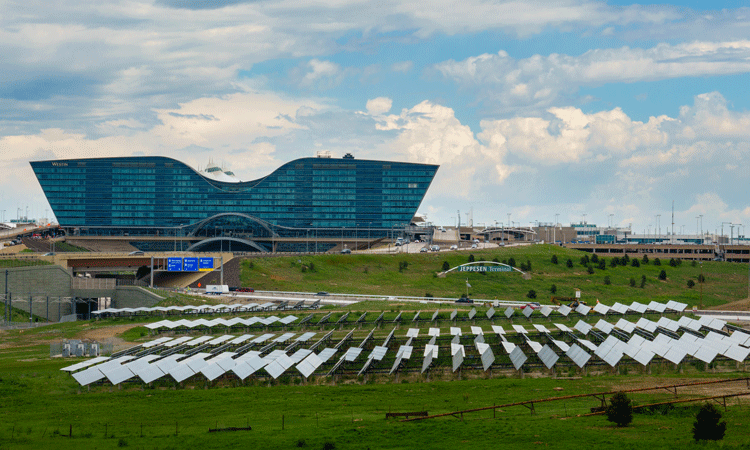Future-proofing airport infrastructure for a changing climate
Posted: 8 April 2024 | Sarah Marquez | No comments yet
Sarah Marquez, Senior Vice President of Airport Operations at Denver International Airport, writes on the importance of future-proofing airport infrastructure, the potential risks airports face due to climate change, and the strategies airports can implement to mitigate these risks.


Credit: DEN.
As the world grapples with the impacts of climate change, it has become imperative for industries across the board to adapt to a rapidly changing environment. One crucial sector that needs to prepare for the challenges posed by climate change is the aviation industry, particularly airport infrastructure. Rising sea levels, extreme weather events, and shifting temperature patterns are a few factors that airports must consider when maintaining or designing new infrastructure.
Airports are critical transportation hubs that connect people and goods across the globe. They play a pivotal role in the economy, tourism and trade. However, with climate change intensifying, the infrastructure that supports airports is increasingly vulnerable to various hazards.
Operational impact and safety
Airport operations must be able to withstand and recover from climate-related disruptions. By future-proofing infrastructure, airports can minimise the impact of extreme weather events, such as hurricanes, floods or heatwaves, on their operations. This resilience is vital in maintaining a safe and efficient aviation system.
Airports are bustling with passengers and employees, and their safety is paramount. Climate change can pose risks to their wellbeing, such as heat stress, increased air pollution and the spread of vector-borne diseases. By designing and retrofitting airport infrastructure to address climate-related risks, the safety of individuals within the airport environment can be safeguarded.
Environmental considerations
Aviation is a significant contributor to greenhouse gas emissions. By future-proofing airport infrastructure, airports can adopt sustainable practices and technologies to reduce their carbon footprint. This includes investing in renewable energy sources, improving energy efficiency, and utilising eco-friendly transportation options within airport premises.
Climate change presents several risks to airports, which can disrupt operations and compromise safety:
Sea-level rise: many airports are located in coastal areas, making them susceptible to rising sea levels. Increased coastal erosion and storm surges can damage runways, terminals and other critical infrastructure. It is estimated that by 2100, approximately 40 major airports around the world could be affected by rising sea levels, including airports in Miami, Amsterdam and Tokyo.
Extreme weather: climate change is intensifying extreme weather events, such as hurricanes, heavy rainfall and heatwaves. These events can disrupt airport operations by causing flight cancellations, delays and damage to infrastructure. For example, in 2012, Hurricane Sandy severely impacted operations at airports along the U.S. East Coast, leading to billions of dollars in losses.
Extreme temperatures: changes in temperature patterns can impact airport infrastructure in multiple ways. Higher temperatures can affect the performance of aircraft, requiring changes in operational procedures. Additionally, extreme heat can lead to the deterioration of pavement and asphalt, causing structural issues on runways and taxiways. Extreme low temperatures can impact facilities heating, pavement and asphalt, as well as some of the fuel sources used by utility plants, airfield vehicles and ground handling equipment, like compressed natural gas (CNG).


Credit: DEN.
Mitigation activities
To mitigate the risks associated with climate change, airports can adopt various strategies for future-proofing their infrastructure.
Risk assessment and adaptation planning: conducting comprehensive hazard risk assessments to identify vulnerabilities is essential. Airports can use these assessment results to develop adaptation plans to address the identified risks. These plans may include measures such as raising infrastructure above projected flood levels, strengthening buildings to withstand strong winds, and implementing drainage systems to manage heavy rainfall.
Sustainable practices: incorporating sustainable practices in the design and construction of new infrastructure is vital. This involves utilising environmentally friendly materials, incorporating energy-efficient systems, and considering the long-term impacts of climate change on the structure’s lifespan. Retrofitting aging infrastructure can also be accomplished to enhance resilience and reduce environmental impact.
Airports can reduce their carbon footprint by transitioning to renewable energy sources. Installing solar panels, wind turbines and geothermal systems allow airports to generate clean energy on-site. Implementing energy-efficient lighting and HVAC systems may also contribute to reducing energy consumption.
Collaboration: collaboration among airports, industry stakeholders, hazard specialists and government bodies is essential for sharing knowledge, best practices and lessons learned. International organisations such as the Airport Council International (ACI) and the International Civil Aviation Organization (ICAO) can play a vital role in facilitating these collaborations and fostering a collective response to climate change challenges. Non-aviation subject matter experts like the National Oceanic and Atmospheric Administration or local Emergency Management Agencies can provide hazard and climate change specific insights to anticipated challenges.
Conclusion
Future-proofing airport infrastructure for a changing climate is an urgent task that must be undertaken to ensure the resilience and sustainability of the aviation industry. Airports can mitigate the risks posed by climate change by identifying vulnerabilities, implementing adaptation measures and embracing sustainable practices. The collaboration between airports, industry organisations and government bodies is crucial to address these challenges collectively. As the aviation sector strives to minimise its impact on the environment, future-proofing airport infrastructure must remain a priority, enabling airports to adapt to the realities of a changing climate and continue to serve as vital global connectors.


The International Airport Summit is open for registration!
Date: 19 – 20 November 2025
Location: JW Marriott Hotel Berlin
At our flagship event of the year, we will dive into the future of airport operations, with expert-led sessions on passenger experience, innovative smart technologies, baggage handling, airside operations, data, security, and sustainability.
This is where global airport leaders come together to share insights, challenges, and real-world solutions.
Limited complimentary passes are available for eligible professionals – first come, first served!

















